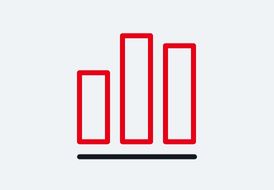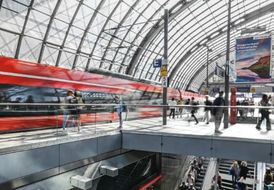Balance sheet
Balance sheet as of Dec 31 / € million | 2022 | 2021 | Change | 2019 | |
absolute | % | ||||
Total assets | 76,303 | 71,843 | +4,460 | +6.2 | 65,828 |
Assets | |||||
Long-term assets | 59,044 | 56,149 | +2,895 | +5.2 | 53,213 |
Short-term assets | 17,259 | 15,694 | +1,565 | +10.0 | 12,615 |
Equity and liabilities | |||||
Equity | 14,679 | 10,621 | +4,058 | +38.2 | 14,927 |
Long-term liabilities | 39,145 | 39,631 | –486 | –1.2 | 32,820 |
Short-term liabilities | 22,479 | 21,591 | +888 | +4.1 | 18,081 |
In 2022, there were no material changes to the International Financial Reporting Standards (IFRS) regulations for DB Group’s consolidation and accounting principles that would result in any changes to the consolidated financial statements.
Since 2022, acknowledgment of debt to fulfill existing purchase commitments (in particular for vehicle purchases at DB Regional and DB Long-Distance) covered by claims of the same amount was reported on the balance sheet (accounting for acknowledgment of debt).
Total assets increased significantly:
- Long-term assets increased significantly, driven primarily by higher property, plant and equipment (€ +2,168 million). This was due to a persistently high level of net capital expenditures, particularly in the Integrated Rail System. In addition, receivables and other assets rose (€ +832 million), due in part to the first-time recognition of acknowledgment of debt and the increase in receivables from transport concessions under IFRIC 12. Intangible assets also rose (€ +467 million), in particular in connection with transport concessions. This was partly offset by the significant decline in deferred tax assets (€ –795 million).
- Short-term assets increased somewhat more sharply. The main factors were:
- this was mainly due to an increase in cash and cash equivalents (€ +547 million),
- the increase in other investments and securities (€ +501 million), due in part to higher short-term cash investments, and
- higher other receivables and assets (€ +445 million) due in part to the first-time recognition of debt acknowl- edgments.
The structure of the assets side remained almost unchanged, with a very slight shift in favor of short term assets.
On the equity and liabilities side, equity increased significantly as a result of the Federal Government’s equity measures in connection with the Climate Action Program (€ +1,125 million) and the partial offsetting of damages due to Covid-19 (€ +860 million). The increase in the changes recorded in the reserves in connection with the revaluation of pensions (€ +2,061 million) and higher changes recorded in the reserves in connection with the market valuation of cash flow hedges (€ +275 million) also increased equity. The net loss for the year (€ 274 million) had a counterbalancing effect.
The more significant increase in equity in comparison to total assets led to a substantial improvement in the equity ratio.
- Long-term liabilities fell slightly. For the most part, this development was shaped by:
- a decline in pension obligations (€ –2,061 million), mainly as a result of an increased interest rate following the revaluation,
- primarily due to higher long-term financial debt (€ +864 million), and
- an increase in other liabilities (€ +592 million) was largely consumed as a result of the first-time recognition of debt acknowledgments.
- Short-term liabilities increased. In essence, this development was characterized by:
- higher other liabilities that become due in the short term (€ +580 million), due in part to the first-time recognition of debt acknowledgments, and
- increased other provisions (€ +277 million), mainly due to additions for revenue discounts at DB Regional.
- The increase in liabilities held for sale (€ +161 million) provided support here, primarily due to the sale of DB Arriva’s activities in Sweden.
- In contrast, the decline in trade liabilities (€ –157 million), mainly at DB Schenker, partially compensated for this.
In terms of the structure of the equity and liabilities side, the increase in equity resulted in a shift that reduced the share of long-term liabilities.


